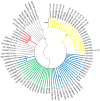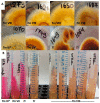Molecular Epidemiology and Antifungal Susceptibility of Trichophyton Isolates in Greece: Emergence of Terbinafine-Resistant Trichophytonmentagrophytes Type VIII Locally and Globally
- PMID: 34072049
- PMCID: PMC8229535
- DOI: 10.3390/jof7060419
Molecular Epidemiology and Antifungal Susceptibility of Trichophyton Isolates in Greece: Emergence of Terbinafine-Resistant Trichophytonmentagrophytes Type VIII Locally and Globally
Abstract
Trichophyton isolates with reduced susceptibility to antifungals are now increasingly reported worldwide. We therefore studied the molecular epidemiology and the in vitro antifungal susceptibility patterns of Greek Trichophyton isolates over the last 10 years with the newly released EUCAST reference method for dermatophytes. Literature was reviewed to assess the global burden of antifungal resistance in Trichophyton spp. The in vitro susceptibility of 112 Trichophyton spp. molecularly identified clinical isolates (70 T. rubrum, 24 T. mentagrophytes, 12 T. interdigitale and 6 T. tonsurans) was tested against terbinafine, itraconazole, voriconazole and amorolfine (EUCAST E.DEF 11.0). Isolates were genotyped based on the internal transcribed spacer (ITS) sequences and the target gene squalene epoxidase (SQLE) was sequenced for isolates with reduced susceptibility to terbinafine. All T. rubrum, T. interdigitale and T. tonsurans isolates were classified as wild-type (WT) to all antifungals, whereas 9/24 (37.5%) T. mentagrophytes strains displayed elevated terbinafine MICs (0.25-8 mg/L) but not to azoles and amorolfine. All T. interdigitale isolates belonged to ITS Type II, while T. mentagrophytes isolates belonged to ITS Type III* (n = 11), VIII (n = 9) and VII (n = 4). All non-WT T. mentagrophytes isolates belonged to Indian Genotype VIII and harbored Leu393Ser (n = 5) and Phe397Leu (n = 4) SQLE mutations. Terbinafine resistance rates ranged globally from 0-44% for T. rubrum and 0-76% for T. interdigitale/T. mentagrophytes with strong endemicity. High incidence (37.5%) of terbinafine non-WT T. mentagrophytes isolates (all belonging to ITS Type VIII) without cross-resistance to other antifungals was found for the first time in Greece. This finding must alarm for susceptibility testing of dermatophytes at a local scale particularly in non-responding dermatophytoses.
Keywords: Greece; Trichophyton spp.; antifungal resistance; dermatophytes; terbinafine.
Conflict of interest statement
The authors declare no conflict of interest.
Figures




Similar articles
-
Emergence of Terbinafine Resistant Trichophyton mentagrophytes in Iran, Harboring Mutations in the Squalene Epoxidase (SQLE) Gene.Infect Drug Resist. 2020 Mar 13;13:845-850. doi: 10.2147/IDR.S246025. eCollection 2020. Infect Drug Resist. 2020. PMID: 32214830 Free PMC article.
-
High terbinafine resistance in Trichophyton interdigitale isolates in Delhi, India harbouring mutations in the squalene epoxidase gene.Mycoses. 2018 Jul;61(7):477-484. doi: 10.1111/myc.12772. Epub 2018 Apr 27. Mycoses. 2018. PMID: 29577447
-
Evaluation of DermaGenius® resistance real-time polymerase chain reaction for rapid detection of terbinafine-resistant Trichophyton species.Mycoses. 2021 Jul;64(7):721-726. doi: 10.1111/myc.13271. Epub 2021 May 18. Mycoses. 2021. PMID: 33760310
-
How to: perform antifungal susceptibility testing of microconidia-forming dermatophytes following the new reference EUCAST method E.Def 11.0, exemplified by Trichophyton.Clin Microbiol Infect. 2021 Jan;27(1):55-60. doi: 10.1016/j.cmi.2020.08.042. Epub 2020 Sep 8. Clin Microbiol Infect. 2021. PMID: 32916260 Review.
-
The Emerging Terbinafine-Resistant Trichophyton Epidemic: What Is the Role of Antifungal Susceptibility Testing?Dermatology. 2022;238(1):60-79. doi: 10.1159/000515290. Epub 2021 May 31. Dermatology. 2022. PMID: 34058736 Review.
Cited by
-
The emergence and worldwide spread of the species Trichophyton indotineae causing difficult-to-treat dermatophytosis: A new challenge in the management of dermatophytosis.PLoS Pathog. 2022 Sep 29;18(9):e1010795. doi: 10.1371/journal.ppat.1010795. eCollection 2022 Sep. PLoS Pathog. 2022. PMID: 36173977 Free PMC article. No abstract available.
-
Evaluation of Gradient Concentration Strips for Detection of Terbinafine Resistance in Trichophyton spp.Antimicrob Agents Chemother. 2023 Jun 15;67(6):e0171622. doi: 10.1128/aac.01716-22. Epub 2023 May 10. Antimicrob Agents Chemother. 2023. PMID: 37162356 Free PMC article.
-
Terbinafine-Resistant Dermatophytes and the Presence of Trichophyton indotineae in North America.J Clin Microbiol. 2023 Aug 23;61(8):e0056223. doi: 10.1128/jcm.00562-23. Epub 2023 Jul 11. J Clin Microbiol. 2023. PMID: 37432126 Free PMC article.
-
Spread of Antifungal-Resistant Trichophyton indotineae, United Kingdom, 2017-2024.Emerg Infect Dis. 2025 Jan;31(1):192-194. doi: 10.3201/eid3101.240923. Emerg Infect Dis. 2025. PMID: 39714510 Free PMC article.
-
The rapid emergence of antifungal-resistant human-pathogenic fungi.Nat Rev Microbiol. 2023 Dec;21(12):818-832. doi: 10.1038/s41579-023-00960-9. Epub 2023 Aug 30. Nat Rev Microbiol. 2023. PMID: 37648790 Free PMC article. Review.
References
-
- Fiammenghi E., Patalano A., Conte V.L., Calabrò G. Cost analysis of inappropriate treatments for suspected dermatomycoses. Farmeconomia Health Econ. Ther. Pathw. 2015;16:39–44. doi: 10.7175/fe.v16i2.1172. - DOI
LinkOut - more resources
Full Text Sources
Miscellaneous

